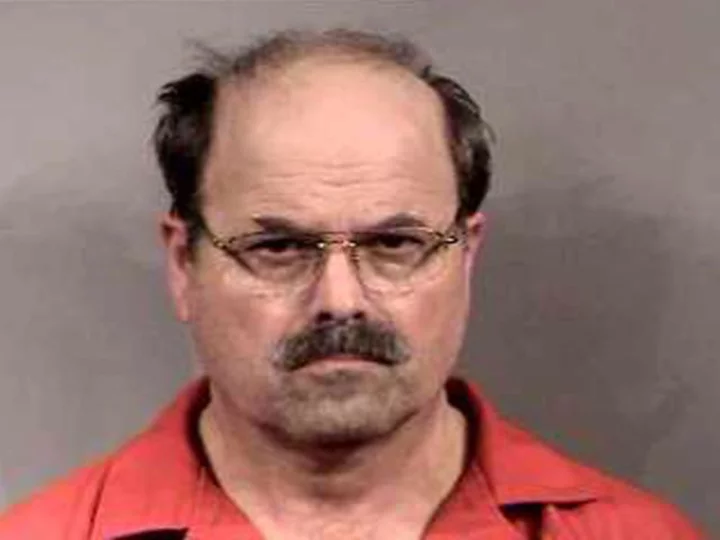A law enforcement team in northeast Oklahoma believes the prolific serial killer known as "BTK" may be responsible for several additional unsolved missing person and homicide cases. Now they're hoping the public can help them identify barns and silos in Oklahoma, Kansas and Missouri that the self-proclaimed BTK killer Dennis Rader sketched in never-before-seen detailed drawings.
Last month, the Osage County Sheriff's Office publicly confirmed it was investigating Rader as the "prime suspect" in a 1976 cold case in their jurisdiction and several other unsolved crimes across three states.
The investigators believe the killer may have buried 16-year-old Cynthia Dawn Kinney in a barn near the Kansas-Oklahoma border. Kinney was last seen at a laundromat in Pawhuska, Oklahoma, in 1976. Her body has never been found.
CNN obtained images of Rader's drawings, which were first recovered by law enforcement after his arrest in 2005.
Rader pleaded guilty to 10 murders that took place from the 1970s to the 1990s in Wichita, Kansas, for which he's serving 10 consecutive life sentences in a state prison. He suggested in a letter found long before his capture that he should be called "BTK," short for "bind, torture, kill."
In recent prison interviews, Rader told Osage County Sheriff Eddie Virden and other local area authorities he did not commit any other murders.
An attorney for the serial killer declined to comment to CNN.
CNN's Jean Casarez sat down with Sheriff Virden for an exclusive interview about Rader's drawings Virden hopes the public can help identify.
The sheriff launched an investigation back in January, poring over Rader's writings, sketches and other evidence he obtained from Wichita police, finding what he believes are potential connections to several unsolved cases in the area.
Officials recovered hundreds of sketches in Rader's belongings after his arrest years ago, but with the help of experts, Virden's team believes a few rare color images may depict more crimes Rader committed.
Months after Kinney disappeared, the Osage County Sheriff's Office documented an anonymous call from a man claiming the teen's body could be found in an old barn along the Oklahoma-Kansas border, Virden told CNN.
Although investigators were able to track down the deputy who answered the call at the time, the barn is still a mystery.
Rader is now known for his signature cat-and-mouse games, sending clues about his murders to law enforcement in the years before he was eventually arrested.
Virden's team believes a barn closely positioned next to a silo was likely a favored haunt of Rader.
"We're hoping that releasing these, someone might recognize one of these barns or the unique features in them, or the closeness of the silo to the barn or possibly might have even found items that they didn't know why were there that could be very important in this case," Virden told CNN.
"Even if the barn's not there anymore. We would still like that information."
Just recently, law enforcement intercepted communications from Rader in prison revealing there may still be some hidden items in old barns, according to the sheriff.
Rader often sketched, according to his daughter Kerri Rawson. He honed the skills in a college drafting class, Rawson told CNN.
"My father did drafting at our house, he drew up plans for the gardens," Rawson said. "And my dad needed to always be outside and be in the air and winter was hard for him. And so we had to find things for him to do because when he got inside and he was too cooped up, he would get all angry."
And he loved barns and silos.
"My father absolutely loves barns and silos. Every time we drove around going camping, fishing, to college, he'd absolutely say this one -- like he said, I want to retire here. And he would tease my mom about it," Rawson told CNN's Jean Casarez in a sit-down interview. "And then after he was arrested, we found out later that he had massive fantasies about those specific locations. So now we're driving around trying to find those by my memory and noting them because we need to go see, is there anybody missing or buried there."
A fascination with barns
CNN exclusively obtained digital images of Rader's disturbing sketches, which show three bound women in what investigators believe to be barns.
One drawing shows what looks like a young female gagged and bound at her arms and legs. Officials point to the black piping running through the barn walls.
"The reason you would have that is if you were moving livestock through there, that those bars would keep the livestock from hitting probably the tin or the wood on the outside of the barn so that if an animal hit it, you know, they wouldn't go through and dent up the tin or knock the wood off the outside," the sheriff told CNN.
Osage County investigators believe the sketch could be linked to a missing woman last seen in Southeast Kansas in 1991.
Her name has not been made public in connection with Rader at this time.
"We know from things Dennis said on this exact photograph that it was a drawing he created from an actual barn," Virden told CNN.
Another color drawing depicts a female victim bound and gagged in a red top.
"That would be a barn that had wood slats. You know, possibly a rounded post but in that area of the barn what would have possibly a wooden floor, you know and a lot of times in tack rooms inside of barns or in feed rooms or storage. They wouldn't leave a dirt floor because they didn't have livestock in that area."
A third drawing Rader penned in black ink, shows an angle glaring down at a female lying in a barn loft space bound by the neck to a staircase post. The staircase construction caught the attention of law enforcement.
"The support post appears to have a bracket and then a bolt that bolts through that to hold everything together," Virden said.
Newly discovered evidence
Last month Virden's team uncovered what Rader called a "hidey hole" containing new evidence not previously discovered by law enforcement on the lot that was once his family home. Bondage materials were among the recovered items, CNN previously reported.
City officials demolished the home in Park City, Kansas in the years after his arrest, but the reinforced hole, according to Virden, remained intact nearly two feet in the ground.
Rader himself led the investigators back to the scene. Virden's team uncovered a letter he wrote in 2008 from prison describing items he hid under the floor of a shed behind his home.
Now Osage County investigators hope state and federal agencies will intervene to help process the evidence that could still contain DNA to connect the serial killer to the unsolved cases or rule him out as a suspect.
They also hope to test "trophies" recovered in 2005, matching the description of items last seen with the victims in the unsolved cases.
A spokesperson for the FBI's Kansas City field office said they were unaware of the FBI actively assisting in any current BTK-related investigations.
The Kansas Bureau of Investigations has met with Osage County officials but has not assisted in any property searches, according to Melissa Underwood, the agency's communications director.
The police force in Pawhuska, Oklahoma, did find an unexpected resource in the serial killer's daughter who's joined the team as a volunteer.
Rawson has walked old haunts with investigators, recalling childhood memories that might be significant, she told CNN.
And she confronted her father for the first time in 18 years, visiting him in prison twice in recent months.
Rader, now 78, is incarcerated at the El Dorado Correctional Facility in Kansas.
Rawson spoke to the man she says she still loves as a father for the first time about his crimes as the BTK serial killer.
She could not elicit a confession, she told CNN. "He's literally sitting six feet across from me. He hasn't seen me in 18 years and he's lying to me."
Rawson and investigators are concerned time is not on their side as evidentiary items age and Rader's health fails in prison.
"He's rotting," his daughter said.
"He has scoliosis very severe. He's in a wheelchair, he has no teeth left, so he doesn't even look like he has a jaw," Rawson said. "He went from this like vivacious man that was hiking with me right before he was arrested, to like an elderly man, you know, his legs wrapped with like bandages."
Rader has access to a phone, television and a tablet device with internet capabilities, according to a spokesperson for the El Dorado Correctional Facility.
He has not spoken out publicly since law enforcement dug up his former family residence, a move uncharacteristic for her dad, according to Rawson.
During her recent visit, Rawson told her father she would sit with him in prison for months straight to learn about all the things he's done, if Rader would confess to more crimes. He has not taken her up on it, Rawson said, but she will not stop trying.
"Now I'm not in contact with him outside of the walls, because it's not safe. If my father is listening to this, he needs to understand that the force that is me is coming for him because I'm done," Rawson told CNN.
"I'm hopeful that even if my father didn't do any of this, we're going to get some answers because there's way too many missing and dead in the Midwest and I'm done," Rawson said.









